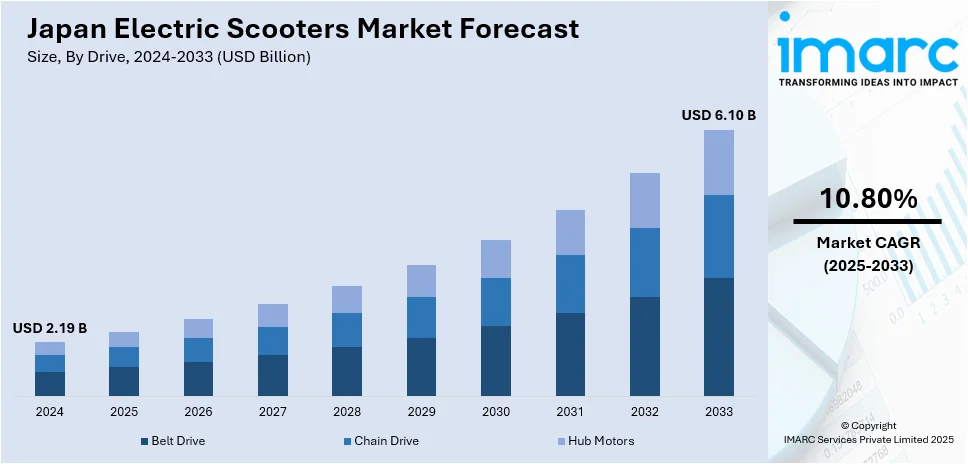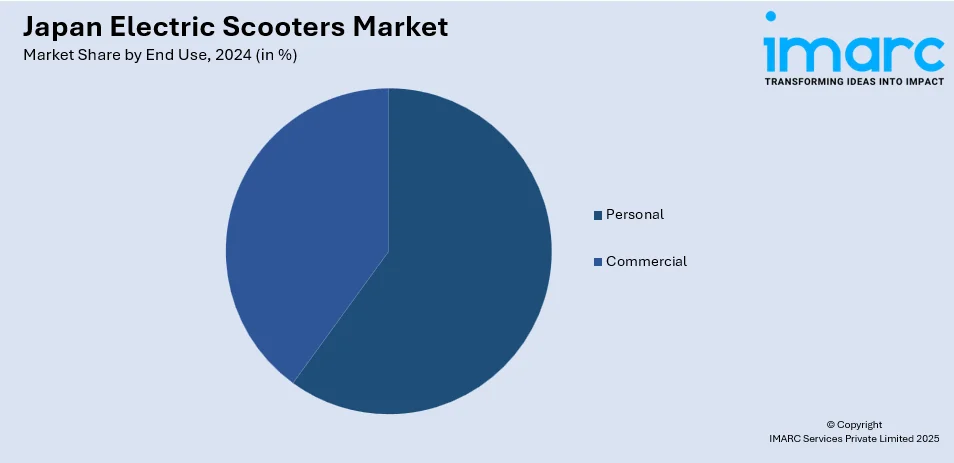
Japan Electric Scooters Market Size, Share, Trends and Forecast by Drive, Battery, Product, Battery Fitting, End Use, and Region, 2025-2033
Japan Electric Scooters Market Overview:
The Japan electric scooters market size reached USD 2.19 Billion in 2024. Looking forward, IMARC Group expects the market to reach USD 6.10 Billion by 2033, exhibiting a growth rate (CAGR) of 10.80% during 2025-2033. The market is witnessing steady growth driven by rising environmental awareness, urban congestion, and government incentives for electric mobility. Technological advancements, such as improved battery life and compact designs, are also attracting urban commuters. Increasing fuel prices, push for sustainable transportation and domestic manufacturers expanding their product portfolios to meet evolving consumer preferences, are some of the other factors further contributing to the Japan electric scooters market share.
|
Report Attribute
|
Key Statistics
|
|---|---|
|
Base Year
|
2024
|
|
Forecast Years
|
2025-2033
|
|
Historical Years
|
2019-2024
|
| Market Size in 2024 | USD 2.19 Billion |
| Market Forecast in 2033 | USD 6.10 Billion |
| Market Growth Rate 2025-2033 | 10.80% |
Japan Electric Scooters Market Trends:
Government Support and Incentives
The Japanese government is actively promoting the adoption of electric scooters as part of its broader efforts to reduce carbon emissions and achieve sustainability goals. Various incentives are being introduced, including subsidies for consumers purchasing electric vehicles, tax breaks, and grants for manufacturers to develop eco-friendly transportation solutions. For instance, in September 2024, Japan announced it plans to invest ¥350 Billion (USD 2.44 Billion) in 12 projects to boost domestic battery production for electric vehicles. Major automakers, including Toyota, Nissan, Panasonic, and Subaru, will develop advanced battery technologies. Toyota aims for 9 GWh capacity, Nissan targets 5 GWh of LFP batteries by 2028, and Mazda seeks 6.5 GWh by 2030. In addition, local authorities in large cities are investing in setting up charging infrastructure to enable the usage of electric scooters. The policies are being pushed by Japan's aim to be carbon-neutral by 2050, as electric scooters are viewed as an efficient solution to urban traffic and air pollution. These initiatives by the government promote not only the expansion of the electric scooter market but also the shift towards cleaner, greener mobility solutions, as envisioned by Japan's environmental goals.

Increasing Investments in Charging Infrastructure
The expansion of electric scooter charging infrastructure is a key factor fueling the growth of the Japan electric scooters market. Major cities are seeing significant investments in building more charging stations, ensuring that users can easily access charging points, thus addressing one of the primary barriers to adoption. For instance, in October 2024, Mitsubishi Motors, in collaboration with MC Retail Energy and Kaluza Japan, launched Japan's first EV smart charging service. This innovative technology allows Outlander PHEV owners to optimize charging based on electricity prices, offering potential cost savings and promoting efficient use of renewable energy while easing peak load on the energy grid. With more charging stations becoming available in public spaces, shopping malls, and near transit hubs, the convenience for electric scooter owners is significantly enhanced. This network expansion not only supports the broader adoption of electric scooters but also contributes to Japan's green mobility initiatives. As the charging infrastructure becomes more widespread, the market for electric scooters is poised for substantial growth, attracting more consumers seeking eco-friendly and cost-effective transportation options in urban areas. The increasing availability of charging options is a crucial factor driving the Japan electric scooter market growth.
Japan Electric Scooters Market Segmentation:
IMARC Group provides an analysis of the key trends in each segment of the market, along with forecasts at the country and regional levels for 2025-2033. Our report has categorized the market based on drive, battery, product, battery fitting, and end use.
Drive Insights:
- Belt Drive
- Chain Drive
- Hub Motors
The report has provided a detailed breakup and analysis of the market based on the drive. This includes belt drive, chain drive, and hub motors.
Battery Insights:
- Lead Acid
- Lithium Ion
- Others
A detailed breakup and analysis of the market based on the battery have also been provided in the report. This includes lead acid, lithium ion, and others.
Product Insights:
- Standard
- Folding
- Self-Balancing
- Maxi
- Three Wheeled
A detailed breakup and analysis of the market based on the product have also been provided in the report. This includes standard, folding, self-balancing, maxi, and three wheeled.
Battery Fitting Insights:
- Detachable
- Fixed
A detailed breakup and analysis of the market based on the battery fitting have also been provided in the report. This includes detachable and fixed.
End Use Insights:

- Personal
- Commercial
A detailed breakup and analysis of the market based on the end use have also been provided in the report. This includes personal and commercial.
Regional Insights:
- Kanto Region
- Kansai/Kinki Region
- Central/Chubu Region
- Kyushu-Okinawa Region
- Tohoku Region
- Chugoku Region
- Hokkaido Region
- Shikoku Region
The report has also provided a comprehensive analysis of all the major regional markets, which include Kanto Region, Kansai/Kinki Region, Central/Chubu Region, Kyushu-Okinawa Region, Tohoku Region, Chugoku Region, Hokkaido Region, and Shikoku Region.
Competitive Landscape:
The market research report has also provided a comprehensive analysis of the competitive landscape. Competitive analysis such as market structure, key player positioning, top winning strategies, competitive dashboard, and company evaluation quadrant has been covered in the report. Also, detailed profiles of all major companies have been provided.
Japan Electric Scooters Market News:
- In August 2024, Honda announced its partnership with Yamaha to supply electric two-wheelers for the Japanese market, enhancing urban mobility options. The agreement includes Honda’s EM1 e: and Benly e: scooters, featuring swappable batteries. This collaboration aims to address industry challenges and promote the adoption of electric motorcycles in Japan.
- In August 2024, Lime, the e-scooter startup backed by Uber, launched its service in Tokyo’s crowded neighborhoods, taking on local leader Luup. With around 200 scooters and 40 charging ports, Lime aims for slow, sustainable growth while adapting to Japan's regulations, which have only recently embraced the shared economy.
Japan Electric Scooters Market Report Coverage:
| Report Features | Details |
|---|---|
| Base Year of the Analysis | 2024 |
| Historical Period | 2019-2024 |
| Forecast Period | 2025-2033 |
| Units | Billion USD |
| Scope of the Report |
Exploration of Historical Trends and Market Outlook, Industry Catalysts and Challenges, Segment-Wise Historical and Future Market Assessment:
|
| Drives Covered | Belt Drive, Chain Drive, Hub Motors |
| Batteries Covered | Lead Acid, Lithium Ion, Others |
| Products Covered | Standard, Folding, Self-Balancing, Maxi, Three Wheeled |
| Battery Fittings Covered | Detachable, Fixed |
| End Uses Covered | Personal, Commercial |
| Regions Covered | Kanto Region, Kansai/Kinki Region, Central/Chubu Region, Kyushu-Okinawa Region, Tohoku Region, Chugoku Region, Hokkaido Region, Shikoku Region |
| Customization Scope | 10% Free Customization |
| Post-Sale Analyst Support | 10-12 Weeks |
| Delivery Format | PDF and Excel through Email (We can also provide the editable version of the report in PPT/Word format on special request) |
Key Questions Answered in This Report:
- How has the Japan electric scooters market performed so far and how will it perform in the coming years?
- What is the breakup of the Japan electric scooters market on the basis of drive?
- What is the breakup of the Japan electric scooters market on the basis of battery?
- What is the breakup of the Japan electric scooters market on the basis of product?
- What is the breakup of the Japan electric scooters market on the basis of battery fitting?
- What is the breakup of the Japan electric scooters market on the basis of end use?
- What is the breakup of the Japan electric scooters market on the basis of region?
- What are the various stages in the value chain of the Japan electric scooters market?
- What are the key driving factors and challenges in the Japan electric scooters market?
- What is the structure of the Japan electric scooters market and who are the key players?
- What is the degree of competition in the Japan electric scooters market?
Key Benefits for Stakeholders:
- IMARC’s industry report offers a comprehensive quantitative analysis of various market segments, historical and current market trends, market forecasts, and dynamics of the Japan electric scooters market from 2019-2033.
- The research report provides the latest information on the market drivers, challenges, and opportunities in the Japan electric scooters market.
- Porter's five forces analysis assist stakeholders in assessing the impact of new entrants, competitive rivalry, supplier power, buyer power, and the threat of substitution. It helps stakeholders to analyze the level of competition within the Japan electric scooters industry and its attractiveness.
- Competitive landscape allows stakeholders to understand their competitive environment and provides an insight into the current positions of key players in the market.
Need more help?
- Speak to our experienced analysts for insights on the current market scenarios.
- Include additional segments and countries to customize the report as per your requirement.
- Gain an unparalleled competitive advantage in your domain by understanding how to utilize the report and positively impacting your operations and revenue.
- For further assistance, please connect with our analysts.
 Request Customization
Request Customization
 Speak to an Analyst
Speak to an Analyst
 Request Brochure
Request Brochure
 Inquire Before Buying
Inquire Before Buying




.webp)




.webp)












